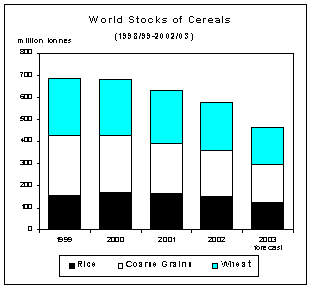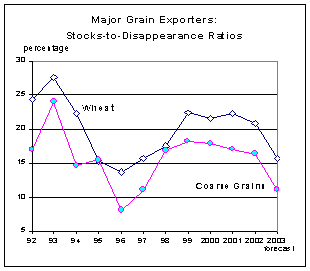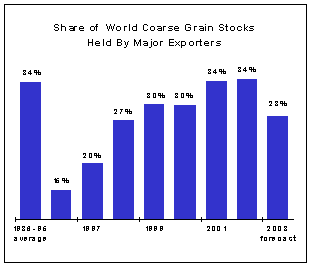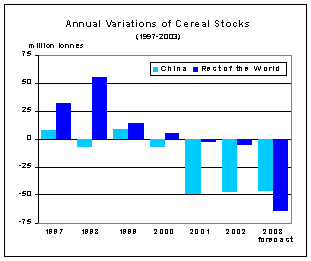


 |
 |
|
 |
||
|
|
||
|
|
|
|
|
| food outlook | |
| No. 1 | Rome, February 2003 |
|
Carryover Stocks
FAO's forecast for global cereal stocks by the close of the seasons ending in 2003 remains unchanged since the last report at 466 million tonnes, which is 111 million tonnes, or 19 percent down from their opening level. This would represent the largest year-on-year variation during the course of the past two decades, bringing world cereal stocks down to their smallest level since the early 1970s. Along with deliberate policies to downsize inventories in important cereal producing countries such as China and India, the reduction in stocks is also driven by the adverse impact on supplies of drought-reduced crops among a number of major exporting countries.  World wheat stocks by the close of the seasons ending in 2003 are forecast to reach 170 million tonnes, around 48 million tonnes, or 22 percent, below their opening levels. In aggregate terms, wheat stocks held by the five major exporters could fall to 33 million tonnes, down 13.5 million tonnes, or 29 percent, from the previous season and the lowest since 1997. As a result, the ratio of their aggregate wheat stocks to their total disappearance (the sum of their domestic consumption and exports) is expected to deteriorate for the third consecutive season to 16 percent, which would be 5 percentage points below the previous season and 2 percentage points below the average since the mid-1990s. Among the major exporters, only the EU is expected to end this season with higher wheat inventories (up 2 million tonnes), supported by a strong rebound in its 2002 production and large imports for the second consecutive season. By contrast, wheat stocks held in the United States are forecast to contract by as much as 9 million tonnes, to a 20-year low of just over 11 million tonnes, reflecting a sharp decline in domestic production. Similarly, with severe drought hampering crops in Australia and Canada, their wheat inventories are also forecast to fall sharply in 2003. World Carryover Stocks of Cereals
Source: FAO
Wheat inventories in China are anticipated to fall again this season to 63 million tonnes, or 24 million tonnes below their reduced opening levels, partly explained by a reduction in 2002 production. However, the main factor behind consecutive declines in China's stocks in recent years has been the policy to downsize large inventories. In India, despite a rise in domestic production in 2002, stocks are forecast to contract by 4 million tonnes to 28 million tonnes. This reduction is mainly driven by a continuing flow of exports, as the Government tries to shrink its large grain stocks in order to lower costs. Despite the near-record wheat production in Pakistan, large exports coupled with strong domestic demand would result in a drop of some 3.5 million tonnes in its stocks. Sharp drawdowns are also anticipated in several countries in Africa, in particular among countries where production fell in 2002, such as in Algeria and Tunisia. By contrast, wheat stocks in most CIS countries are expected to increase. Total wheat stocks in the CIS countries are forecast at 17 million tonnes, up 2 million tonnes from the previous season and highest level since 1995. As a result of rising exports, stocks in the Russian Federation could decline slightly this season, while end-of-season inventories in most other CIS countries, including all other large wheat producers such as Kazakhstan, Ukraine and Uzbekistan, could actually increase as a result of good harvests in 2002.  World coarse grain inventories for crop years ending in 2003 are forecast to decline by 38 million tonnes to 172 million tonnes. Among the major exporters, the sharpest fall is expected in the United States, where, because of poor harvests, end-of-season stocks are forecast to drop by 47 percent to 24 million tonnes. While maize stocks in the United States are forecast to decline most, by 19 million tonnes, barley and sorghum inventories are also likely to contract significantly. A drop in barley production in Australia and Canada is also expected to lower coarse grain stocks in those countries, while in the EU, reductions in maize and rye output would be mostly responsible for a small decrease in total coarse grain stocks. On the whole, the ratio of major exporters' total coarse grain stocks to their total disappearance is forecast to plunge considerably, falling to 11 percent, which would be significantly below the estimated 16 percent in the previous season.  Elsewhere, total stocks in Mainland China are forecast at 82 million tonnes, which would be 7 million tonnes smaller than in the previous season despite a strong rebound in 2002 coarse grain (mostly maize) output. The decline is mainly the result of larger anticipated maize exports and continuing strong demand for feed grains in the domestic market. Coarse grain stocks in most CIS countries are expected to remain unchanged from the previous season, but barley stocks in the Russian Federation and Ukraine are forecast to decline, as exports are expected to expand. Barley inventories are also forecast to contract sharply in Turkey given static supplies in the face of larger expected demand for feed and exports. A decline in maize production in Brazil is forecast to result in a drawdown of stocks in that country, leading to a tighter domestic balance than in the previous season. In Africa, smaller production would be mostly responsible for declines in coarse grain carryovers in several countries, including maize stocks in Kenya, Ethiopia and Uganda as well as sorghum stocks in Sudan. In Zimbabwe, normally a country with large exportable maize supplies, the drop in domestic maize production for two years consecutively could deplete stocks.  The forecast of world rice stocks at the end of the marketing seasons in 2003 has been revised downward by almost 2 million tonnes since the last report and now stands at 124 million tonnes, one of the lowest levels on record, and almost 25 million tonnes below their opening level. The reduction in the size of world inventories confirms the continuation of the tendency that has prevailed since 1999, when China initiated a deliberate policy to reduce the size of its grain inventories. Unlike in recent years, however, the contraction this season was not just attributable to China, but also to India, which engaged last year a similar strategy to cut public rice reserves. Based on the new estimate, the global stock-to-utilization ratio for rice would now stand at 30 percent, down from the peak of 42 percent in 2000. The lowering of the world stock forecast since the last report mainly reflects the downward revision for India's production, which, combined with a higher estimate of exports, resulted in an additional 2.5 million tonnes drawdown from the country's rice inventories, to 15 million tonnes. This would imply a year-on-year reduction in India's stocks of almost 10 million tonnes from their opening levels. Similarly, for China, larger shipments than previously anticipated in 2002 have reduced the size of the country's rice carry-over by a further 700 000 tonnes to 78.3 million tonnes. At this level, China's stocks would be depleted by almost 15 million tonnes from last year and by an overall 35 million tonnes since 2000. Downward adjustments have also been made to the forecast stocks in Cambodia, reflecting the deterioration of the production prospects in 2002, and in the United States, following on improved outlook for trade in the current year. By contrast, the forecasts for Indonesia's carryovers have been raised, following the improved 2002 crop prospects. |
|||||||||||||||||||||||||||||||||||||||||||||||||||||||||||||||||||||||||||